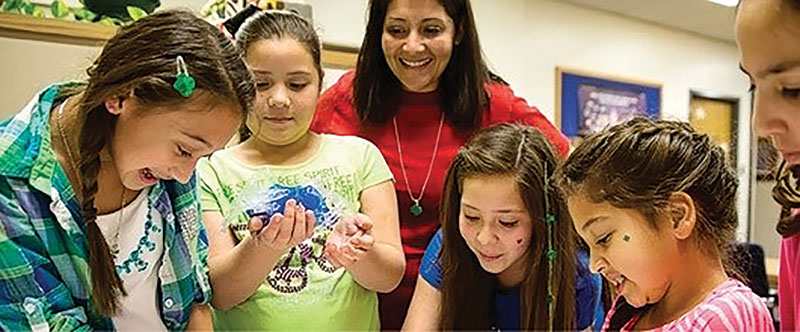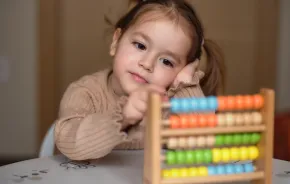
Editor’s note: In this nine-month series we explore how new voluntary standards developed in Washington state are impacting the quality of after-school programs that serve about 134,000 youths after the school bell rings. We will explain what parents should seek in a program, look at research on the impacts of quality care on kids’ development and academics and visit with programs that are successfully serving kids and helping families. After-school Special’s independently reported content is funded by a journalism grant in partnership with the Raikes Foundation and School’s Out Washington. See the full series of articles here.
On a recent weekend, with bare winter trees reflecting on Lake Langlois at Camp River Ranch in Carnation, dozens of middle-school-age Girl Scouts gather inside nearby Helena’s Lodge and do some reflecting of their own. Led by female volunteers, the girls discuss the media and how their own self-images and identities are shaped by media messages.

Gigi Morrison, a mom from Sammamish whose 12-year-old daughter has been in a Girl Scouts of Western Washington troop since kindergarten, kicks off one focus group by playing the powerful Like a Girl video, produced by Always, which, since its release last summer, has gone viral, tallying more than 53 million YouTube views. Then Morrison gently nudges the girls into talking.
“What does doing something 'like a girl' mean to you?”
“It means doing something wrong or funny,” one girl offers. “It means I’m going to do it the best I can,” says another. Another adds, “But sometimes it’s actually other girls who are the ones who make me feel bad.”
Morrison is soft-spoken. She encourages a safe space for all girls to share their thoughts without being judged. “I’m so pro-girl,” she says, explaining why she volunteers her time for this project and other Girl Scouts after-school programs. This particular discussion holds special meaning for her. The 54-year-old was once a talented ninth-grade athlete who had the misfortune of coming of age before Title IX’s implementation.
“I was a better basketball player than half of the boys out there, but I wasn’t allowed to play on the team with the boys. I had to get their water for them,” Morrison says.
To say that volunteers like Morrison make the world go ’round may seem like a cliché. But for many nonprofit organizations, volunteers are the horsepower that allows them to serve more people. For more than a century, volunteers have brought personal experiences, professional expertise and passion to the national Girl Scouts organization. Now, Girl Scouts of Western Washington (GSWW) is leading the way in adopting program quality standards as part of its volunteer development. “We want all girls, regardless of income, geography or anything else, receiving consistently high-quality experiences,” says Lorey Ford, who oversees quality work for GSWW.
It is no small challenge: With 11,000 volunteers serving about 26,000 girls in 17 western Washington counties, using an assessment tool usually reserved for paid employees is exciting and sometimes challenging, according to organization leaders. “Rolling out the Youth Program Quality (YPQ) process to this sheer number of volunteers just hasn’t been done at this scale anywhere else in the country,” says Samantha Bannon, manager of program quality initiatives.
Like roughly 100 other organizations across Washington state, the Girl Scouts have in the past three years voluntarily implemented the quality standards with staff, many of whom have youth development backgrounds. The assessment tool covers nine domains, including ongoing staff and volunteer development, as well as youth leadership and engagement, and family, school and community connections. As ParentMap has reported in this series, research shows that quality after-school programs can boost students’ academic achievement and social-emotional health. Because the assessment categories are specific, measuring, for instance, “how well staff supports youth with encouragement,” there are quantifiable results to guide both staff and volunteers in a journey of continual improvement. Parents, too, can better measure program quality.
After daylong trainings, program volunteers undergo both self-assessments and external assessments with professional trainers. The more accurate their assessments are, the more nimble and successful programs like the Girl Scouts can be in building and maintaining a high-quality corps of essential volunteers. The better trained the volunteers are, the better the programs will be at serving kids and families in that critical 3–6 p.m. window.
“We want to be supportive so that volunteers want to continue to participate,” says Girl Scouts program manager Julie Wendell. Forging a new path in a way no others have done before: Now that is acting like a girl.











